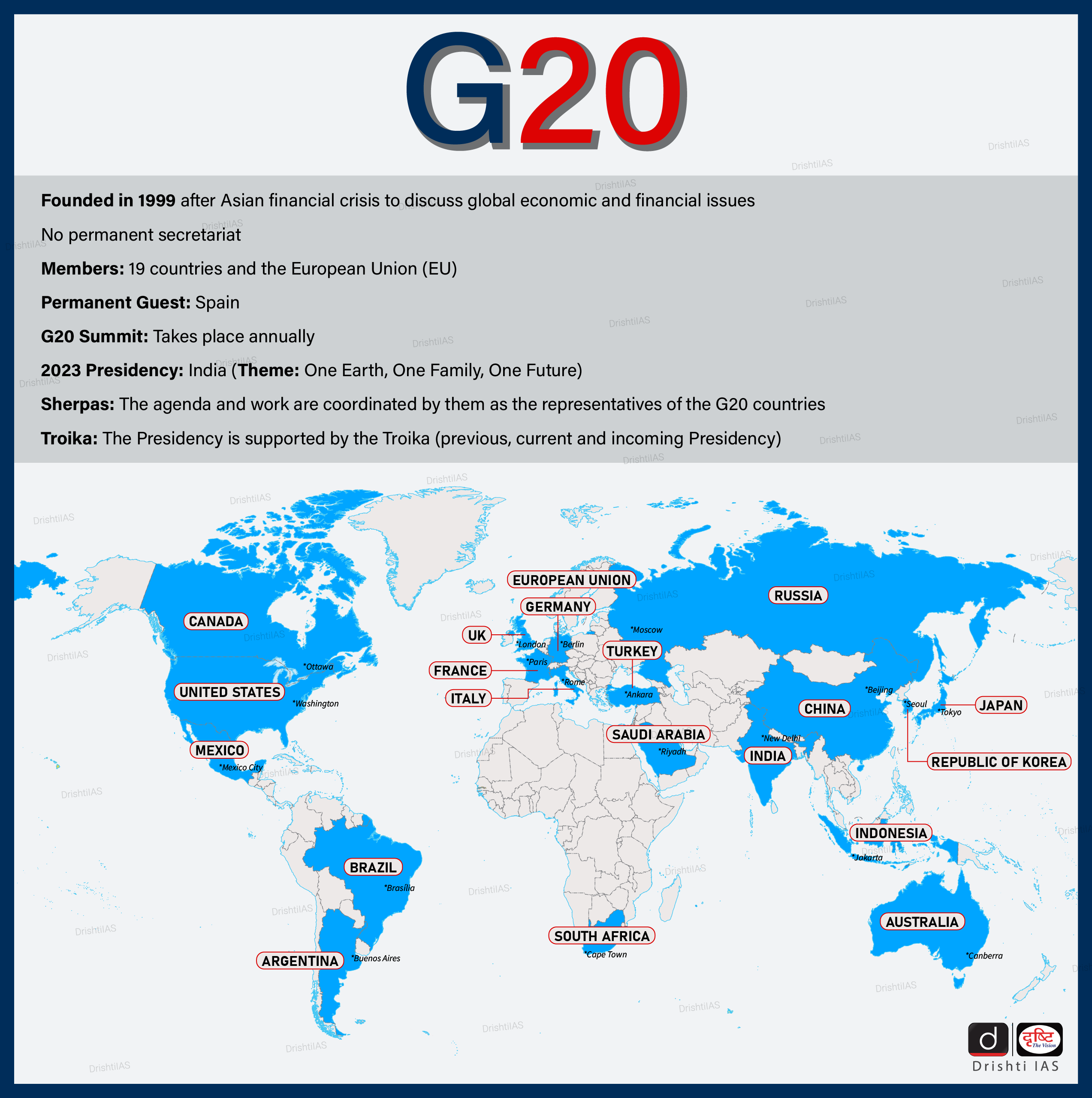G20 Countries and Disaster Risk Reduction | 26 May 2023
For Prelims: Disaster Risk Reduction, G-20, Early Warning System, Extreme Weather Events, Heatwaves.
For Mains: Strategies for Disaster Risk Reduction.
Why in News?
Recently, the First G20 Disaster Risk Reduction Working Group (DRR WG) meeting under India’s G20 Presidency took place, where India highlighted the importance of Disaster Risk Reduction (DRR).
What are the Highlights of the Meeting?
- The G20 Disaster Risk Resilience Working Group has called upon governments to build a social protection system with an effective and preferred instrument for disaster risk financing.
- It emphasised the need for new-age Social Protection Systems that invest in local risk resilience to mitigate, prepare and recover from disasters.
- The five priorities outlined:
- Global coverage of Early Warning Systems
- Increased commitment towards making infrastructure systems disaster resilient
- Stronger national financial frameworks for DRR
- Strengthened national and global disaster response system
- Increased application of ecosystems-based approaches to DRR
- The G20 DRR WG intended to include considerations for the Sendai Framework’s mid-term review, renew multilateral cooperation at all levels, and inform future global policies and initiatives related to DRR.
What is the Need for Creating a Collective G20 Framework for Disaster Risk Reduction?
- The G20 nations, with a population of 4.7 billion, have large exposure, risk from asset concentration, and vulnerability to natural disasters.
- In the current World Risk Index, four out of the top 10 vulnerable countries are G20 nations.
- The combined estimated annual average loss in the G20 countries alone is USD 218 billion, equivalent to 9% of the average annual investment in infrastructure made by them.
- Disaster risk reduction measures can play an important role in preventing such losses.
What can be the key Strategies for Reducing Disaster Risk?
- Better Economic and Urban Development:
- Reducing risk can be achieved mainly by reducing vulnerability and exposure to risk through measures such as better economic and urban development choices and practices, protection of the environment, reduction of poverty and inequality, etc.
- For example, in India, effective implementation of flood risk management strategies can help in reducing and managing Extreme Weather Conditions.
- Reducing risk can be achieved mainly by reducing vulnerability and exposure to risk through measures such as better economic and urban development choices and practices, protection of the environment, reduction of poverty and inequality, etc.
- Financing:
- There is a need to re-imagine financing disaster risk reduction. The financing requirements flowing through government budgets are not independent of a country’s fiscal position and hence may be limited.
- Innovative financing tools including creating reserve funds, dedicated lines of credit and tapping resources globally should be explored.
- Infrastructure:
- Infrastructure, such as roads, rails, airports, and electricity lines created through public revenues need to be resilient to disasters and may require more funds incrementally.
- There is a need to finance this additionality using options that are reflective of the social benefits of such disaster-resilient infrastructure.
- Dealing with Extensive and Intensive Risk:
- Differential strategies to deal with extensive risk (risk of losses from frequent but moderate impacts) and intensive risk (from low frequency and high impact events), should be worked out.
- A large portion of the losses accumulate from extensive events.
- Cumulatively, dispersed events such as Heatwaves, lightning, local floods, and landslides cause enormous losses. Implementing targeted approaches to reducing losses from extensive risk events can have an impact in the short to medium-term horizon.
- Multi-tiered, Multi-sectoral Effort:
- There is a need to view disaster risk reduction as a multi-tiered, multi-sectoral effort.
- If efforts are integrated vertically from local to sub-national to national to global, and horizontally across sectors, the level of readiness to manage unknown risks will be enhanced.
- The world is interlinked and interdependent, and the G20 can help develop such strategies.
What are the Initiatives for Disaster Risk Reduction?
- Global:
- Sendai Framework for Disaster Risk Reduction 2015-2030
- The Climate Risk and Early Warning Systems (CREWS)
- International Day for Disaster Risk Reduction - 13th October
- Green Climate Fund’s Sectoral Guide on Climate Information & Early Warning Systems
- India’s Initiatives:
Way Forward
- The G20 should foster collaboration and coordination among its members and other stakeholders on early warning systems, disaster-resilient infrastructure, financial frameworks and response systems for disaster risk reduction.
- They should promote innovation and research on disaster risk reduction, especially on the use of technology, data and ecosystems-based approaches.
- There is a need to align disaster risk reduction efforts with the 2030 Agenda for Sustainable Development, the Paris Agreement on Climate Change and the New Urban Agenda and ensure that no one is left behind.
- The Working Group on Disaster Risk Reduction is an opportunity for the G20 to take a lead in the implementation of the Sendai framework over the next seven years.
UPSC Civil Services Examination Previous Year Question (PYQ)
Prelims:
Q. In which one of the following groups are all the four countries members of G20? (2020)
(a) Argentina, Mexico, South Africa and Turkey
(b) Australia, Canada, Malaysia and New Zealand
(c) Brazil, Iran, Saudi Arabia and Vietnam
(d) Indonesia, Japan, Singapore and South Korea
Ans: (a)
Mains:
Q. Discuss the recent measures initiated in disaster management by the Government of India departing from the earlier reactive approach. (2020)
Q. Vulnerability is an essential element for defining disaster impacts and its threat to people. How and in what ways can vulnerability to disasters be characterized? Discuss different types of vulnerability with reference to disasters. (2019)
Q. Describe various measures taken in India for Disaster Risk Reduction (DRR) before and after signing ‘Sendai Framework for DRR (2015-30)’. How is this framework different from ‘Hyogo Framework for Action, 2005’? (2018)

